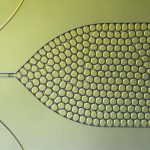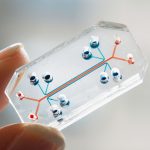- ME 555 Microfluidic Theory
Flow in microsystems behaves very differ ent than flow on the macroscale, i.e., the flow we are used to in our everyday life. The most obvious difference is that the chaotic turbulent flow we most often observe, e.g., rivers flowing or tap water running does not appear on the microscale. Here, the flow is more smooth and most often what we call laminar flow. Other parameters considered important on the macroscale such as inertia are insignificant on the microscale, whereas viscosity becomes extremely important.
ent than flow on the macroscale, i.e., the flow we are used to in our everyday life. The most obvious difference is that the chaotic turbulent flow we most often observe, e.g., rivers flowing or tap water running does not appear on the microscale. Here, the flow is more smooth and most often what we call laminar flow. Other parameters considered important on the macroscale such as inertia are insignificant on the microscale, whereas viscosity becomes extremely important.
- ME 444 Introduction to Microfluidics
 Microfluidics deals with fluids flowing in miniaturized systems. It is a young discipline, which is expected to substantially expand over the next few years, stimulated by the considerable development of applications in the pharmaceutical, biomedical and chemical engineering domains.The behavior of fluids at the microscale can differ from “macrofluidic” behavior in that factors such as surface tension, energy dissipation, and fluidic resistance start to dominate the system. Microfluidics studies how these behaviors change, and how they can be worked around, or exploited for new uses.
Microfluidics deals with fluids flowing in miniaturized systems. It is a young discipline, which is expected to substantially expand over the next few years, stimulated by the considerable development of applications in the pharmaceutical, biomedical and chemical engineering domains.The behavior of fluids at the microscale can differ from “macrofluidic” behavior in that factors such as surface tension, energy dissipation, and fluidic resistance start to dominate the system. Microfluidics studies how these behaviors change, and how they can be worked around, or exploited for new uses.
- ME 340 Heat Transfer

Heat is defined in physics as the transfer of thermal energy across a well-defined boundary around a thermodynamic system. Heat transfer is the exchange of thermal energy between physical systems. The rate of heat transfer is dependent on the temperatures of the systems and the properties of the intervening medium through which the heat is transferred. The three fundamental modes of heat transfer are conduction, convection and radiation.
- ME 328 Manufacturing Process
- ME 425 Heat Exchangers